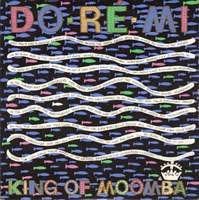King of Moomba (song)
"King of Moomba" is a single by Australian rock/pop group Do-Ré-Mi released by Virgin Records in May 1987 and later appeared on their second album The Happiest Place in Town.[1][2] The song was written by lead vocalist Deborah Conway, drummerDorland Bray, bass guitarist Helen Carter and guitarist Stephen Philip.[3][4] While the B-side "Tearing up the Carpet" was written by Carter and Philip.[3] Their 1985 single "Man Overboard" had been a surprise top 5 hit,[5][6][7][8] but "King of Moomba", from their second album, which was produced by Martin Rushent, had less chart success peaking at #52.[1] Moomba in the song's title refers to the annual festival held in Melbourne which had an appointed 'King of Moomba' from 1967–1987 and was then replaced by a 'Moomba Monarch'.[9]
| "King of Moomba" | ||||
|---|---|---|---|---|
 7" single cover | ||||
| Single by Do-Ré-Mi | ||||
| from the album The Happiest Place in Town | ||||
| A-side | "King of Moomba" | |||
| B-side | "Tearing up the Carpet" | |||
| Released | May 1987 | |||
| Genre | New wave, rock | |||
| Label | Virgin Records | |||
| Songwriter(s) | Deborah Conway, Dorland Bray, Helen Carter, Stephen Philip | |||
| Producer(s) | Martin Rushent | |||
| Do-Ré-Mi singles chronology | ||||
| ||||
Background
Do-Ré-Mi had formed in Sydney in 1981 when Deborah Conway (lead vocals) and Dorland Bray (drums, percussion, backing vocals), both previously in Melbourne-based group The Benders, joined Helen Carter (bass, backing vocals) ex-Friction.[4] Stephen Philip (guitar), ex-Thought Criminals, was initially a studio musician for their debut EP, Do-Ré-Mi released in August 1982 and was asked to join formally.[2] They returned to the studio almost immediately and recorded The Waiting Room EP which was released in January 1983. "Man Overboard" was released as a single in June 1985, from Domestic Harmony on Virgin Records, and peaked at #5 on the Australian singles charts.[5] "King of Moomba ", from their second album The Happiest Place in Town, which was produced by Martin Rushent, had less chart success, peaking at #52.[1] Moomba in the song's title refers to the annual festival held in Melbourne which had an appointed 'King of Moomba' from 1967–1987 and was then replaced by an appointed 'Moomba Monarch'.[9] The 'Kings of Moomba' for the 1980s were TV actor Paul Cronin (1980), former footballer Lou Richards (1981), film, TV and stage actor Frank Thring (1982), TV personality Daryl Somers (1983), footballer Kevin Bartlett (1984), TV personality Ian "Molly" Meldrum (1985), motor racing driver Peter Brock (1986) and champion doubles tennis player Paul McNamee (1987).[9]
Track listing
All tracks were written by Deborah Conway, Dorland Bray, Helen Carter and Stephen Philip, except where noted.[3]
- "King of Moomba"
- "Tearing up the Carpet" (Carter, Philip)
Personnel
Do-Ré-Mi members
- Dorland Bray — drums, percussion, backing vocals
- Helen Carter — bass guitar, backing vocals
- Deborah Conway — lead vocalist
- Stephen Philip — guitar
References
- McFarlane, Ian (1999). "Encyclopedia entry for 'Do-Ré-Mi'". Encyclopedia of Australian Rock and Pop. Allen & Unwin. ISBN 1-86448-768-2. Retrieved 2008-10-15.
- Nimmervoll, Ed. "Do-Ré-Mi". HowlSpace – The Living History of Our Music (Ed Nimmervoll). Archived from the original on 27 July 2012. Retrieved 10 February 2014.
- "Australasian Performing Right Association". APRA. Archived from the original on 2007-12-05. Retrieved 2008-10-14. Note: requires user to input song title e.g. King of Moomba
- Holmgren, Magnus. "Do-Ré-Mi". Australian Rock Database. Passagen.se (Magnus Holmgren). Archived from the original on 5 November 2013. Retrieved 16 March 2014.
- Kruger, Debbie (14–20 July 2004). "Once more with feeling". Melbourne Weekly Bayside Magazine. Retrieved 2008-10-14.
- "Long Way To The Top article on Helen Carter". Australian Broadcasting Corporation. Retrieved 2008-10-14.
- "Deborah Conway Official Website". Deborah Conway. Retrieved 2008-10-14.
- Harris, Anna (30 January 2004). "Deborah Conway - still alive and brilliant". Archived from the original on 2006-05-14. Retrieved 2008-10-14.
- Bellamy, Craig; Gordon Chisholm; Hilary Eriksen (17 February 2006). Moomba: A festival for the people (PDF). pp. 17–22. ISBN 0-9578702-7-2. Archived from the original (PDF) on 25 August 2006. Retrieved 2008-10-15.